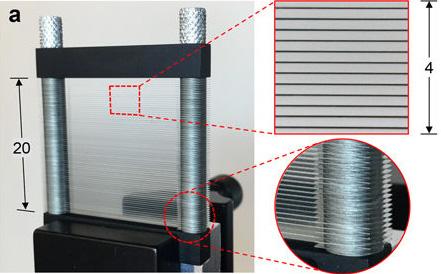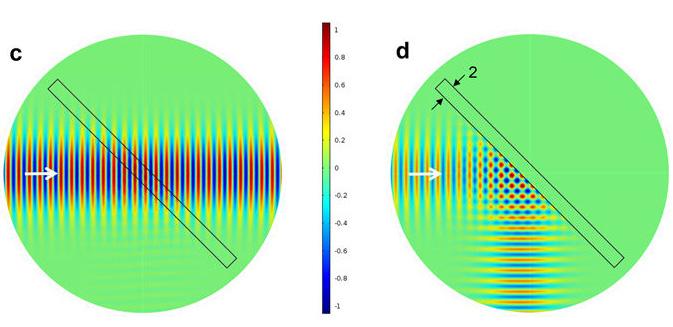A novel technique for manipulating the polarization of light at terahertz (THz) frequencies uses stacks of closely spaced steel plates to make a polarizing beamsplitter (PBS). Each pair of plates forms a parallel-plate waveguide. When THz light is shined on the stack at a 45-degree angle, it splits the beam by exciting two waveguide modes. One beam of vertically polarized light passes straight through the device, while another beam of horizontally polarized light is reflected in a 90-degree angle from the original beam axis.

Researchers have used a new technique to create a polarizing beamsplitter for terahertz waves. Courtesy of Mittleman Lab/Brown University.
The approach is based on an artificial dielectric medium — a uniformly spaced stack of metal plates that is the electromagnetic equivalent to a stacked array of parallel-plate waveguides — that is scalable to a range of frequencies. The operation of the device relies on the lowest-order, transverse-electric and transverse-magnetic modes of the parallel-plate waveguide. This is in contrast to existing methods of manipulating polarization in the THz range, which rely primarily on the transverse electric mode.
The PBS demonstrated extinction ratios as high as 42 decibels (dB) in transmission and 28 dB in reflection with overall insertion loss of 0.18 dB.
Building on their experimental PBS, the research team, from Brown and Osaka Universities, added a second similar artificial dielectric structure to demonstrate a THz isolator with nonreciprocal transmission, providing an isolation of 52 dB and an insertion loss less than one dB, at a frequency of 0.46 THz. The performance of the team’s isolator exceeded that of other experimentally demonstrated THz isolators, and came close to the performance of commercially available isolators for optical wavelengths.

Researchers have developed a new device that can split a beam of terahertz radiation by polarization state. Courtesy of Mittleman Lab/Brown University.
The waveguide-based artificial dielectrics are low loss, inexpensive and easy to fabricate, making this approach a potentially promising route for polarization control of free-space Thz beams.
“This stack-of-plates idea has advantages over traditional methods of manipulating polarization in the terahertz region,” said professor Dan Mittleman. “It’s cheaper and physically more robust than other methods.”
The plates are also much less fragile than traditional wire filters. Polarizing filters for THz are typically an array of metal wires a few microns in diameter and spaced several microns apart.
“The artificial dielectric concept also makes the device more versatile,” professor Rajind Mendis said. "The device can be easily tuned for use at different terahertz frequencies simply by changing the size of the spacers separating the plates or by changing the illuminating angle."
Such a beamsplitter could be useful in a wide variety of systems that use THz radiation, from microscopy to future communications networks. Use of THz waves in technological applications such as spectroscopy, sensing, imaging and ultrahigh-bandwidth communications is growing, and researchers are working to develop the hardware components necessary to build these advanced THz systems.
The researchers are in the process of patenting the new artificial dielectric devices, and are hopeful that these devices will enable the development of new THz systems with far better capabilities.
“In anything you might want to do with an optical system, it's useful to be able to manipulate polarization,” Mittleman said. “This is a simple, efficient, effective and versatile way to do that.”
The research was published in Scientific Reports (doi:10.1038/s41598-017-06297-7)